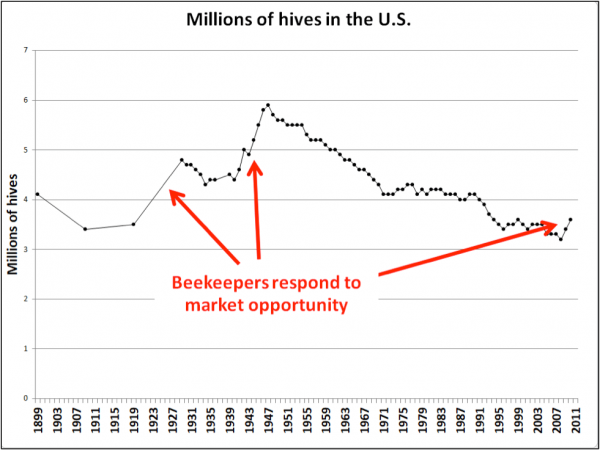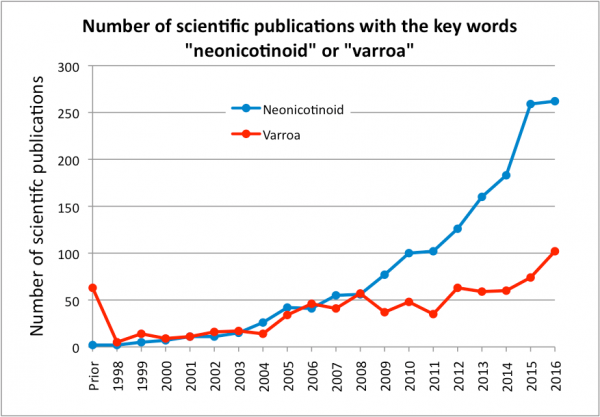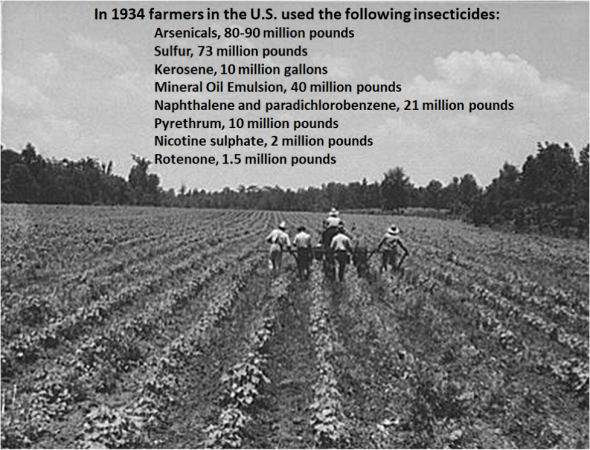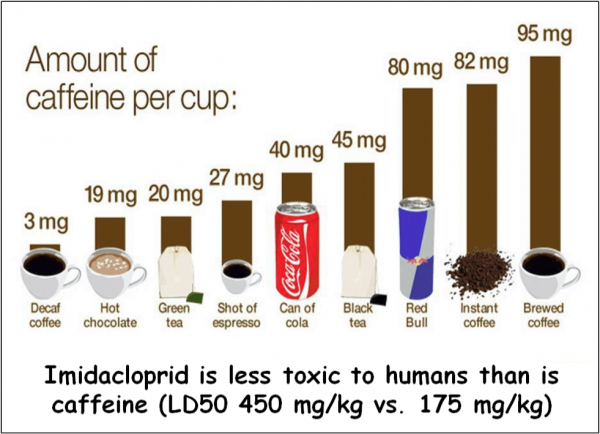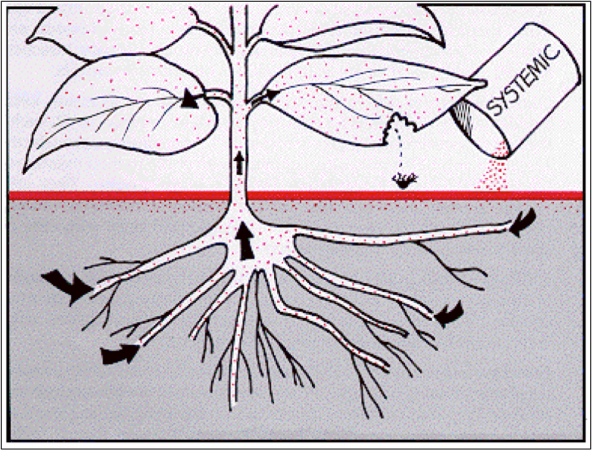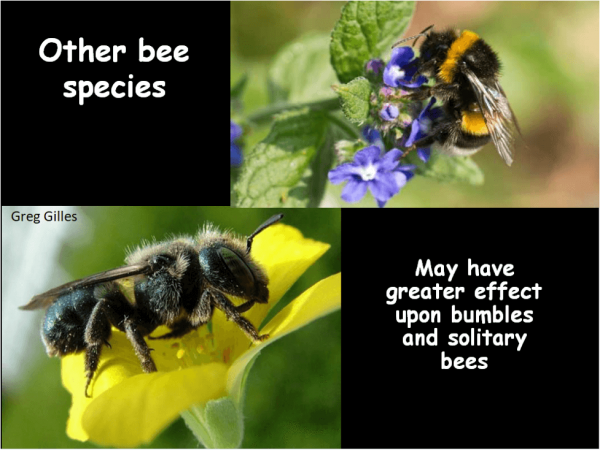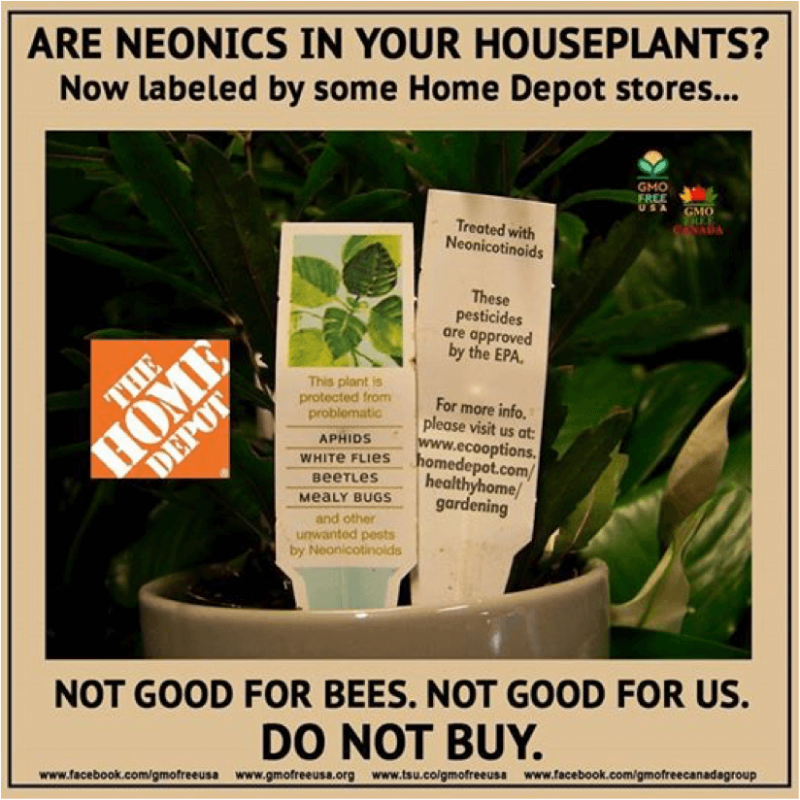The Neonicotinoids: An Objective Assessment
The Neonicotinoids: An Objective Assessment
Randy Oliver
ScientificBeekeeping.com
April 2018
Updated 26 January 2020*
(I wrote this article in response to a request following a presentation that I gave to the San Diego Master Gardeners. A revised version was later published by the University of California at http://ucnfa.ucanr.edu/files/280172.pdf)
Everyone’s heard about the claim that honey bees are going extinct due to the neonicotinoid insecticides. Although I’m glad that folk are concerned about the bees, the fact is that that claim is not accurate.
People have every reason to be concerned about our human impact upon the environment, and many species face extinction due to habitat conversion, pollution, overharvesting, and climate change. But the honey bee is not one of them. In actuality, the number of managed hives of bees has been increasing in recent years in nearly every country in the world. Colony numbers reflect the profitability of beekeeping as a business, as reflected in the graph below.
The largest number of hives in the U.S. occurred during World War II, due to the Army’s demand for beeswax, and the public’s demand for honey. After the War, beekeeping was less profitable, and the number of hives decreased. We then got hit by the introduction of two parasitic mites in the late 1980’s, and hive numbers declined further as it became tougher to keep our colonies alive. In recent years, the offered price for hive rental for almond pollination tripled, so colony numbers are on the rise.
In the early 2000’s, our bees got hit by yet another invasive pathogen (Nosema ceranae), and the term “CCD” was used to describe the sudden collapse of colonies. But at the time we didn’t know what was happening, which allowed the claim that a new class of insecticides—the neonicotinoids—were responsible. It was a compelling narrative—was this a repeat of DDT causing the near extinction of the pelicans and raptors? I immediately started researching the subject, but found to my surprise, that the narrative didn’t fit the evidence. But that didn’t stop the anti-neonic bandwagon, and researchers switched from working on our main problem—the varroa mite—to trying to pin the blame on the neonics.
Although varroa was a hot topic upon its arrival in Europe and North America, scientific interest in the parasite was eclipsed during the CCD epidemic in the mid 2000’s by the sexier claim that the neonics were to blame.
Why The Neonics?
Growers have long used insecticides, many of which we now know are not at all environmentally friendly.
Since the founding of the EPA in the post Silent Spring era, we are taking a better look at the impacts of pesticides upon off-target organisms, the environmental fates of the products, and their long-term sublethal effects—especially upon humans. EPA has thus phased out the “Dirty Dozen” Persistent Organic Pollutants. And in recent years has revoked or restricted the use of a number of others. For example, the previously commonly-used organophosphate chlorpyrifos is no longer registered for use as a household bug spray.
The problem is, that as we limit the number of insecticides available to growers, pests develop resistance to regularly-applied products. That, and the fact that the vast majority of a sprayed insecticide never actually hits the intended pest—thus ending up in the air, water, and rest of the environment. Growers thus put pressure on the chemical companies to continually develop new types of pesticides, while the consumer demands safer products.
Enter The Neonicotinoids
The neonicotinoids (meaning new, nicotine-like) are synthetic derivatives of the natural plant alkaloid nicotine. The neonics affect specific receptors in the nervous system of insects that are less prevalent in vertebrate animals, so they are thus much safer for humans, other mammals, birds, and fish. In fact, the most commonly-used neonic, imidicloprid, is less toxic to humans than is caffeine.
The second advantage of the neonics is that they are systemic—they can be absorbed through a plant’s roots, and get carried via the xylem to the rest of the plant. Thus, if they are applied as a seed treatment, the only organisms exposed to the chemical are the pests that take a bite out of the plant, or consume the pollen or nectar (this is where bees enter the picture).
Image credit [a].
Because of these advantages, neonics quickly became the most widely-used insecticides in the world.
Imidacloprid quickly became a very popular insecticide, due to it’s reduced risk to humans and other vertebrates, as well as because pest insects had developed resistance to other insecticides. As far as overall environmental impact, the neonic clothianidin–used mainly as a seed treatment on corn and soybeans — may be of greater import.
Effects of Neonics on Bees
Neonics are ideally applied as seed treatments, where the amount per seed can be carefully controlled, so that by the time that a plant produces nectar and pollen, the residues are too diluted to harm pollinators.
Unfortunately, during the introduction of the neonics, there were some serious incidents of inadvertent bee kills when the seed coating rubbed off in pneumatic seed planters, and the dust killed bees. In most countries, this issue has now been resolved.
This leaves the question of neonic residues in nectar and pollen. In general, the residues in the nectar and pollen of properly-treated agricultural crops (typically less than 3 ppb) do not appear to cause significant adverse effects on honey bee colonies. I’ve personally visited beekeepers in corn, soy, and canola growing areas, and they report that since the Bt genetically-engineered crops and the neonic seed treatments, that the pesticide issues that they suffered from in the 1960’s and ‘70’s have largely gone away. That said…
The Neonics Are Not Without Problems
Insecticides by definition are designed to kill insects. No insecticide is environmentally harmless, and as we learn more about unintended effects, our regulators must revise the approved allowable applications.
We have now found that the honey bee colony is a special case, and is able to “buffer” the sublethal effects of the neonics on the colony. So although properly-applied neonics appear to generally cause minimal measureable adverse effects on honey bee colonies, they may have more deleterious effects upon bumblebees and solitary native bees. This is a serious concern, of which the EPA is well aware.
Another concern is that with the widespread prophylactic use of neonic seed treatment, more and more residues are ending up at the field margins and in aquatic ecosystems. We’re recently finding out that certain uncultivated plants in the field margins concentrate neonic residues in their nectar and/or pollen. A recent study in Saskatchewan found residues up to 20 ppb in some flowers—enough to start causing problems in bee hives (serious problems occur at 50 ppb), and strong adverse effects upon some native pollinators. These unintended effects upon native pollinators and aquatic invertebrates need to be addressed, and the universal use of treated seed should be restricted.
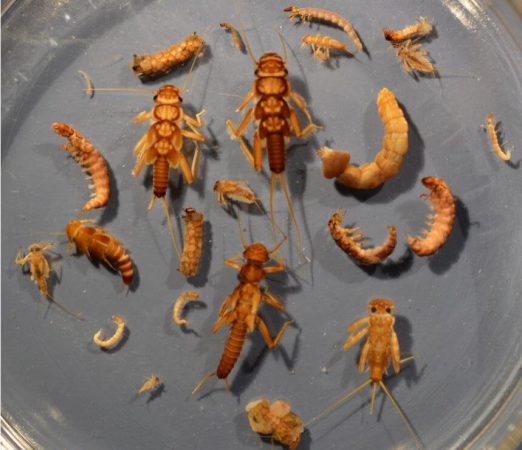
The “health” of aquatic ecosystems is often monitored by the presence of indicator species, such as those above. These species serve as the base of the aquatic food chain. Pesticide residues affect some species more than others. Photo credit: freshwaterbenthicmacroinvertebrateservices.com
I’m heartened by a recent Court ruling regarding a challenge to EPA, which apparently did not consult with the FWS or the NMFS regarding its approval of some registrations of clothianidin–see https://www.courthousenews.com/wp-content/uploads/2017/05/epa-pesticides-ruling.pdf
Uses other than as seed treatments
Neonics can also be applied as sprays, drenches, or other foliar applications, or by chemigation. There is far more room for misapplication by these methods. And perhaps worst of all would be misapplication by homeowners, who think that “if a little is good, more might be better.” Luckily, in the studies I’ve seen, urban and suburban bee-collected pollen and nectar normally does not contain toxic levels of neonics.
And this brings us to neonic applications in nursery stock. Nurserymen, in order to ship stock across state lines, must produce pest-free plants. This requires insecticides. But nurserymen do not want to expose their employees and customers to residues of organophosphates such as chlorpyrifos. They can avoid this by placing a measured amount of a neonic in the potting soil, which then, due to its systemic action, results in “clean” plants, and no human-harmful residues. Ideally, by the time a pollinator-attractive plant produces flowers, the residues would be diluted enough so as not to cause harm. The problem is, that no one has individually tested the thousands of cultivars of nursery plants. Plus there is no list of which cultivars attract pollinators.
There have been consumer protests at the big box nurseries, and nurserymen are scrambling to figure out answers.
Jim Bethke and I are currently involved in an IR-4 Project at Rutgers University to address this issue. Currently, we can’t really say which nursery plants might be problematic for pollinators. However, you can generally check a garden book to see if a cultivar is attractive to bees or butterflies; if so, at this time you may wish to avoid pollinator-attractive neonic-treated potted plants, and plant from seed instead.
Wrap up
No insecticide is harmless. All of agriculture should shift towards Integrated Pest Management to reduce its reliance upon pesticides. California is the most proactive state in the Nation as far as safe pesticide use. The ag community and chemical companies have gotten the message loud and clear that the consumer wants them to reduce pesticide use and develop more eco-friendly pesticides—both of which they are doing.
Write to your representatives to support the EPA, which our current administration is attempting to shut down. Support local eco-friendly growers. Buying “organic” may help, but the best future will be the adoption of agro-ecology, which goes beyond “certified organic.” The field of agroecology is based upon biology, soil improvement, and sustainability, rather than upon “certified organic’s” arbitrary rules that exclude precision breeding and environmentally-friendly synthetic pesticides, fertilizers, and practices. Keep in mind that it is the housewife who spends her dollars at the grocery store who can effect the most rapid change—even the largest agribusinesses respond immediately to consumer demand.
*Update 26 January 2020
An excellent and thorough review of our state of knowledge is by Wood and Goulson:
The environmental risks of neonicotinoid pesticides: a review of the evidence post 2013.
https://www.ncbi.nlm.nih.gov/pmc/articles/PMC5533829/
Their closing summary regarding non-target organisms is:
However, whilst these aforementioned factors are all important, it is still possible to comment on likely outcomes based on average exposure levels across a range of studies. This is as true for other taxa as it is for bees. Given these caveats, it is clear that since 2013, new research has substantially advanced our understanding of the effect of neonicotinoids on non-target organisms in the following areas:
-
Non-flowering crops treated with neonicotinoids can pose a risk to non-target organisms through increasing mortality in beneficial predator populations.
-
Neonicotinoids can persist in agricultural soils for several years, leading to chronic contamination and, in some instances, accumulation over time.
-
Neonicotinoids continue to be found in a wide range of different waterways including ditches, puddles, ponds, mountain streams, rivers, temporary wetlands, snowmelt and groundwater and in outflow from water processing plants.
-
Reviews of the sensitivity of aquatic organisms to neonicotinoids show that many aquatic insect species are several orders of magnitude more sensitive to these compounds than the traditional model organisms used in regulatory assessments for pesticide use.
-
Neonicotinoids have been shown to be present in the pollen, nectar and foliage of non-crop plants adjacent to agricultural fields. This ranges from herbaceous annual weeds to perennial woody vegetation. We would thus expect non-target herbivorous insects and non-bee pollinators inhabiting field margins and hedgerows to be exposed to neonicotinoids. Of particular concern, this includes some plants sown adjacent to agricultural fields specifically for the purposes of pollinator conservation.
-
Correlational studies have suggested a link between neonicotinoid usage in agricultural areas and population metrics for butterflies, bees and insectivorous birds in three different countries.
More Reading
[a] From Cloyd, Bethke, Cowles (2011) Systemic Insecticides and Their Use in Ornamental Plant Systems. Floriculture and Ornamental Biotechnology. Global Science Books.
https://scientificbeekeeping.com/the-extinction-of-the-honey-bee/
https://scientificbeekeeping.com/neonicotinoids-trying-to-make-sense-of-the-science/
https://scientificbeekeeping.com/neonicotinoids-trying-to-make-sense-of-the-science-part-2/




